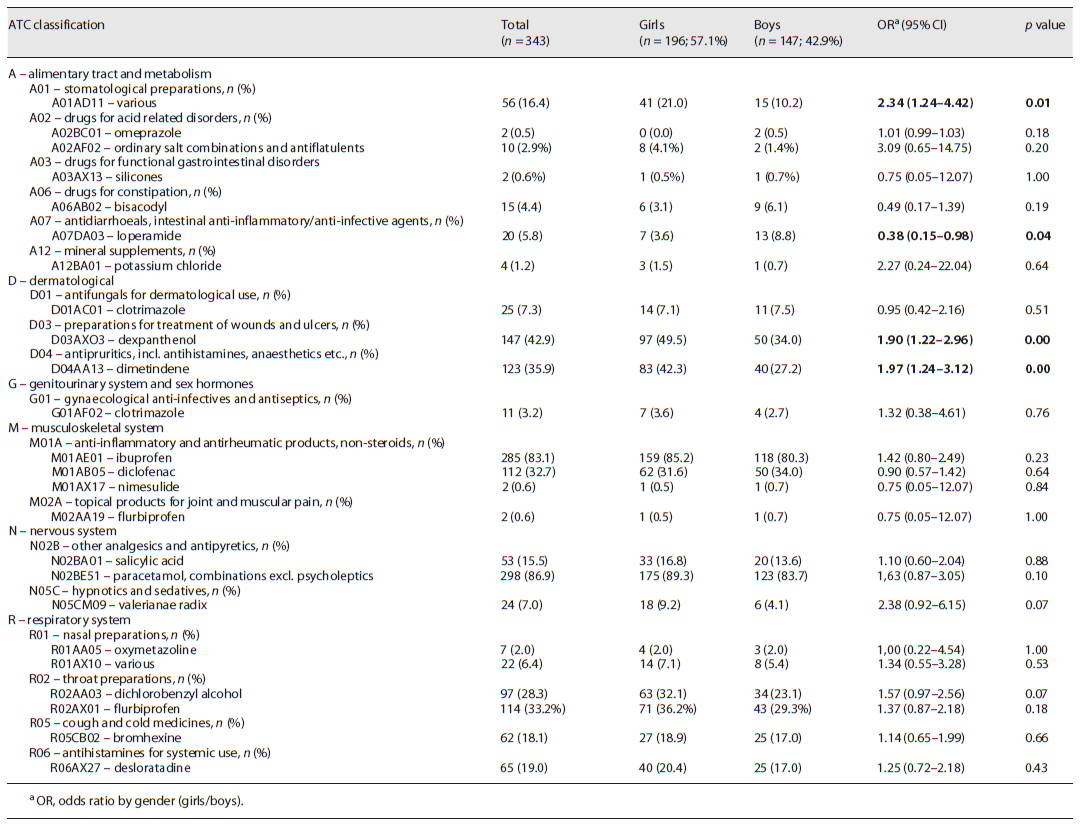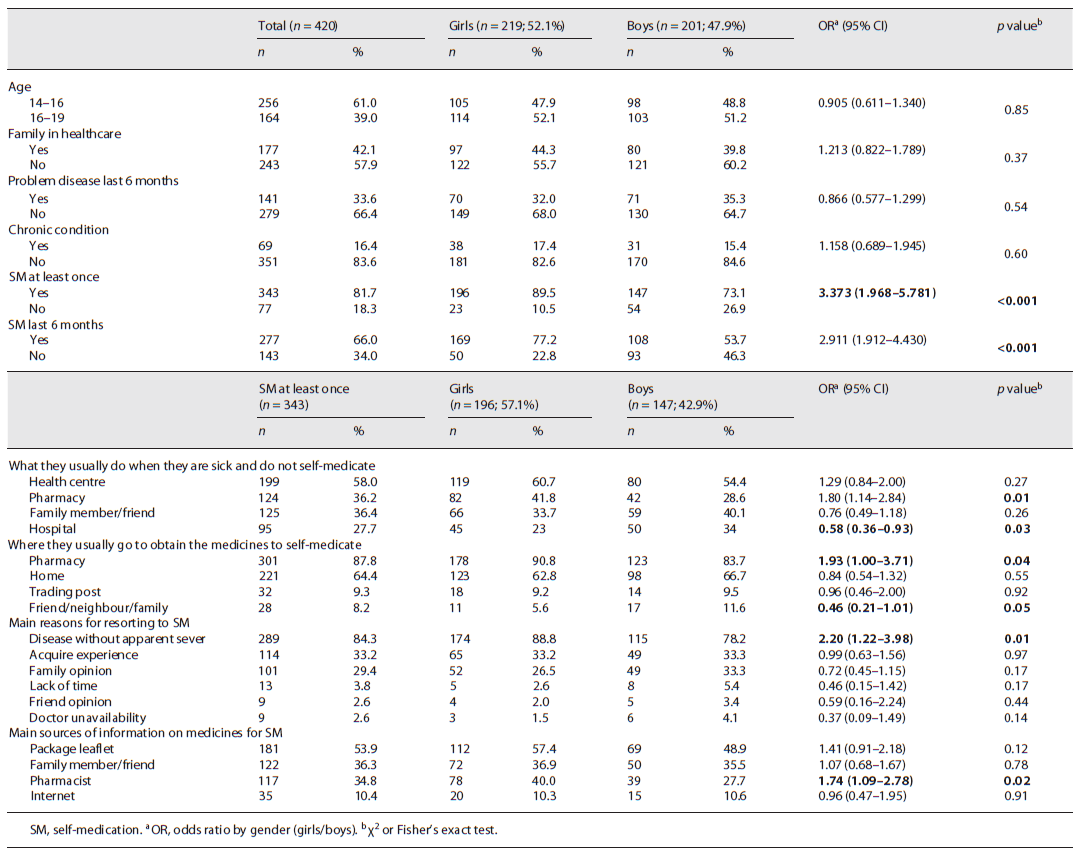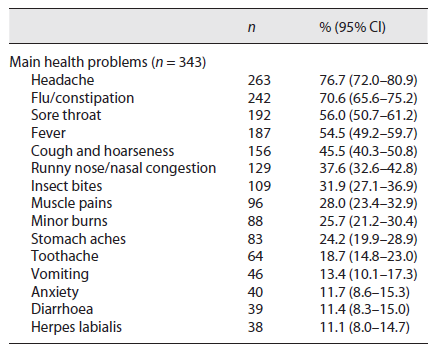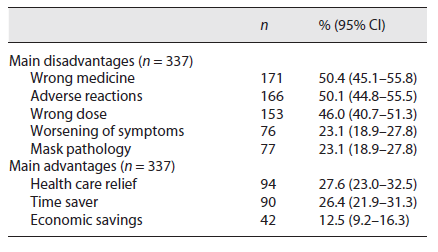Introduction
Self-medication is an increasingly frequent phenomenon worldwide. Regardless of the individual’s cultural level, historical context, or economic and social status, self-medication has become a common practice 1-3. It is defined as the use of over-the-counter medications (OTC drugs) by the patient or by the person responsible for him, who decides which drug to use to treat, relieve symptoms, or even promote health 4,5.
The World Health Organization defends the importance of self-medication responsibility through the use of OTC drugs, to prevent and treat diseases that do not need a medical prescription. However, it is also recognized that responsible self-medication must be accompanied by appropriate health information 6-10.
Although there are medications that can be purchased without a medical prescription, the patient should not misuse them. Because young people, especially adolescents, represent a group strongly predisposed to irrational use of medications, OTC drugs are being misused by this group due to exposure to advertisements and the media. Therefore, self-medication is considered one of the health risk behaviours found among adolescents 11-14. The main sources of self-medication are family, friends, neighbours, pharmacy professionals, previously prescribed medications, or suggestions from advertisements in newspapers or magazines.
The practice of self-medication must be based on authentic information under the advice of health professionals to avoid misuse of the medication. Irrational self-medication increases the risk of adverse effects, can waste resources, and increase pathogen resistance 1,3,7,9,15,16.
The self-medication behaviour will vary depending on several socioeconomic characteristics, such as educational and economical levels. Higher economic and educational levels allow people not only to have better access to health education but also to have easy access to medicines. The improvement of knowledge, education, and socioeconomic levels and the development of new technologies promote the practice of self-medication worldwide 2,6,8,13,14.
Although responsible self-medication helps save time and reduce the cost of treatment, it is not risk-free, particularly for certain therapeutic and target groups (children, adolescents, pregnant women, elderly, and chronically ill). Therefore, providing adolescents with appropriate knowledge concerning the use of medication is a necessary measure for responsible self-medication 3,8,9,17.
Despite the widespread use of self-medication among the adolescent population and its potential harm, up-to-date epidemiological data on this subject are scarce in Portugal. Therefore, the study aimed to evaluate the practice of self-medication among Portuguese adolescents between 14 and 19 years old, the various factors influencing it, the main health problems motivating this practice, and the type of drugs used. It is expected that the results obtained will contribute to the reduction of self-medication and lead to the promotion of alert actions concerning the risks of improper use of medicines.
Materials and Methods
A questionnaire based on the cross-sectional study was conducted to assess the practice of self-medication among adolescents and evaluate the factors which are related to this practice. The study lasted for 6 months, and the data collection period lasted from September to December 2018.
The sample was obtained from two public schools in Central Portugal, one urban and the other rural, using the convenience sampling technique. Inclusion criteria were adolescents in secondary school, aged under 20 years. After permission was given by the directors of the schools of the study, a meeting was held with the directors of each class of the students who agreed to participate and, in the case of minors, with the permission of their parents, to clarify the objectives of this study, as well as to request their collaboration in data collection. All 896 high school students (33 classes) from the study schools were invited to participate. All classes accepted to participate and, overall, 420 students accepted (46.7% student response rate).
Data were collected through a pre-tested semi-structured questionnaire divided into two parts: the first part allows the characterization of the sample, while the second part evaluates the practice and drugs used for self-medication and the factors that influence it. A list of drugs was presented for the participants to indicate which ones they had already used for self-medication, and if any of the drugs were on the list, they could add them. The drugs were then classified according to the Anatomical Therapeutic Chemical Classification System, that is, the ATC classification system (level 1, organs or systems; level 2, therapeutic subgroup; level 5, drug). To verify that the questions were correctly formulated and were well understood by the adolescents, a pre-test was applied to 27 adolescents. The questionnaires were answered by the adolescents, individually and in the presence of the class director, to avoid the exchange of opinions that could influence the answers.
Categorical variables were described by frequency and respective 95% confidence intervals (95% CI) and continuous variables by mean and standard deviation. χ2 or Fisher’s exact test (whenever appropriate) are used for comparison between the categorical variables. Binary logistic regression models were performed to examine the factors related to self-medication in the last 6 months, and the odds ratio (OR) and the respective 95% CI were computed. Associations were considered statistically significant at a p value less than 0.05. Statistical analysis was performed by using software IBM SPSS v.24 (National Opinion Research Center, Chicago, IL, USA) and GraphPad Prism v. 6.04 (La Jolla, San Diego, CA, USA).
Results
The gender-specific main characteristics of the study population are described in Table 1. Of the 420 adolescents questioned, 219 (52.1%) are female and aged between 14 and 19 years, the average being 16.03 ± 1.228 years (mean ± standard deviation). 177 (42.1%) of the adolescents mentioned having a family member working in the health area, 141 (33.6%) revealed a health problem in the last 6 months, and 69 (16.4%) a chronic condition. The prevalence of using at least one drug by self-medication was three times higher in girls (OR = 3.37, 95% CI: 1.97-5.78). When adolescents were asked about “what they usually do when they are sick,” “go to the hospital” was more mentioned by boys (OR = 0.58, 95% CI: 0.36-0.93) and “go to the pharmacy” by girls (OR = 1.80, 95% CI: 1.14-2.84). More than half of the adolescents (64.4%) also reported that they obtain the medicines for self-medication at home. When asked about the main reasons for resorting to self-medication, 84.3% of the adolescents mentioned that they do it when they consider the disease is not serious, and this answer was two times more prevalent in the girls (OR = 2.20, 95% CI: 1.22-3.98). The main health problems that motivate adolescents to self-medicate are headaches (76.7%), followed by flu or colds (70.6%), sore throat (56%), and fever (54.5%), as shown in Table 2.
To obtain information or additional clarifications about the medicines for self-medication, girls were the ones who used pharmacists the most (OR = 1.74, 95% CI: 1.09-2.78), as shown in Table 1. Of the respondents who self-medicated, 74.8% (95% CI: 70.0-79.2) revealed that they were aware of self-medication risks and 97.6% (95% CI: 95.6-98.9) denied having had any problem with self-medication taking.
In Table 3, we can see the main advantages and disadvantages related to self-medication, in adolescents referred to. The main advantages mentioned were the contribution not to overload health services (27.6%) and saving time in solving the health problem (26.4%). Half of the adolescents (50.4%) reported that taking the wrong medication can be a disadvantage and not being able to identify possible adverse reactions (50.1%).
Prevalence of self-medication use by medication class and most frequently used drugs. A total of 1,829 medicines were recorded in the study sample. Of these, drugs act on the musculoskeletal system (M00, 21.9%), nervous system (N00, 20.5%), respiratory system (R00, 20.1%), and skin (D00, 16.1%) were most frequently used. In contrast, genitourinary system and sex hormones (G00, 0.6%) were used much less frequently.
As shown in Table 4, the most frequently used medicines were paracetamol, combinations excl. psycholeptics (N02BE51) were reported by 86.9% of the adolescents, followed by ibuprofen (M01AE01) with 83.1%. They were followed by the preparations for the treatment of wounds and ulcers, dexpanthenol (D03AX03) and dimentidene (D04AA13) with 42.9% and 35.9%, respectively, flurbiprofen (R02AX01) reported by 33.2% of adolescents and diclofenac (M01AB05) with 32.7%. Girls were significantly more likely to use A01AD11 - various (OR = 2.34; 95% CI: 1.24-4.42), D03AXO3 -dexpanthenol (OR = 1.90; 95% CI: 1.22-2.96), and D04AA13 - dimetindene (OR = 1.97; 95% CI: 1.24-3.12) than boys. Boys, on the other hand, used significantly more A07DA03 - loperamide (OR = 0.38; 95% CI: 0.15-0.98) than girls.
Table 4 Distribution of pharmaceuticals used for self-medication according to groups and subgroups of Anatomical Therapeutic Chemical (ATC) classification (World Health Organization) by gender

Prevalence of self-medication in the last 6 months
Regarding the prevalence of self-medication in the last 6 months, 277 (66.0%; 95% CI: 61.4-70.5) of the adolescents admitted this practice. As suggested by results of binary logistic regression, only gender and having medicines available at home were having significant association with the prating of self-medication in the last 6 months by adolescents. The prevalence is higher in girls (OR = 2.40, 95% CI: 1.35-4.26; p = 0.00) and those who have medicines at home (OR = 2.56, 95% CI: 1.44-4.56; p = 0.00). Although there was no significant association of age with self-medication in the last 6 months, the oldest are the ones who are most aware of the existence of risks associated with self-medication (OR = 0.57, 95% CI: 0.33-0.97), as well as the important role of health professionals in providing advice and clarifying doubts (OR = 0.59; 95% CI: 0.38-0.93). They are also the ones who most recognize the advantage of not overloading health services (OR = 0.59; 95% CI: 0.36-0.95) and the disadvantage of masking other pathologies (OR = 0.37; 95% CI: 0.22-0.62). It was also found that female adolescents are the ones who least recognize self-medication the faster response to the problem (OR = 0.48; 95% CI: 0.29-0.78) and a greater risk of dose error (OR = 0.62; 95% CI: 0.40-0.96).
Discussion
In our study, a very high prevalence of self-medication at least once (81.7%; 95% CI: 77.8-85.2) was found among adolescents aged 14-19 years. Lower values were reported by Abahussain et al. 18 (92%), Shehnaz et al. 19 (89.2%), and Westerlund et al. 20 (88%), in adolescents in the same age group. In contrast, the percentage reported by Moraes et al. 21 was 52.6% and Silva and Giuliani’s 22 was even lower at 12.3%. We also found a higher prevalence of self-medication in girls, similar to what has been reported in other studies 7,23. It is important to note that the abuse of medications by adolescents can be aggravated by their ease of access and lack of adult supervision, in a group that asserts its autonomy in the practice of self-medication by not consulting a doctor or health professional previously 7,15.
Of all medicines used (n = 1,829), non-steroid anti-inflammatory and antirheumatic products (21.8%), analgesics/antipyretics (19.1%), and throat preparations (11.5%) were the therapeutic groups most used for self-medication, with paracetamol and ibuprofen being the most consumed medicines. Also, in a study carried out in 2016 in Taiwan with 6,226 adolescents, the most commonly reported drugs for self-medication were non-steroidal anti-inflammatory drugs (31.1%), cough or cold medication (21.6%), and analgesics (19.3%) 24. These results are in line with other published studies that confirm these therapeutic groups as the most used in self-medication 4,7,11,15,23. It is important to emphasize that the consumption of analgesics/antipyretics/anti-inflammatory drugs is favoured by the ease of purchase since they are OTC drugs. Adolescents use medicines without a prescription on the assumption that they have sufficient knowledge to take responsibility for making decisions and taking care of their health. Therefore, it is of utmost importance that they are properly informed and educated for their correct use.
More than two-thirds of the adolescents in our sample reported that self-medication is used for headaches (76.7%) and flu/cold (70.6%), and more than half report sore throat (56%) and fever (54.5%), which is consistent with the most frequently used drugs reported by them. Our results support those of other research studies showing the widespread use of analgesics for self-medication 5,7,13,14,23. The prevalence of pain among adolescents has been identified as a major public health problem, with an estimated 15%-25% of adolescents suffering from chronic or recurrent pain, such as headaches and abdominal pain 25. It is of utmost importance to enlighten young people about the importance of proper diagnosis and treatment of pain to prevent persistent or recurrent conditions to avoid overuse of analgesics.
When designing an intervention scheme to promote safe self-medication practice, understanding the sources of information is very helpful. In our study, although 87.8% of adolescents reported going to the community pharmacy to purchase medications for self-medication practice, only 34.8% reported the pharmacist as a source of information, and no other health professionals were mentioned. In comparison, in the study conducted in Taiwan 24, a higher percentage of pharmacist involvement was observed at 82.9%. The importance that health professionals, particularly pharmacy professionals, have in transmitting knowledge about the rational use of medicines is particularly important in adolescents who, in general, do not have enough knowledge to detect the health problem, nor to decide which medicine to use, the correct dose, and dosage 23,24,26-28.
Helal and Abou-ElWafa (2017) report that the main reasons for self-medication are the disease without apparent severity (73.9%) and the experience acquired previously (71.4%), in agreement with the present study (84.3%) that revealed the disease with no apparent severity as the main reason for adolescents to resort to self-medication, followed by previously acquired experience (33.2%) 17. Shehnaz et al. 7 explain the high prevalence of self-medication in adolescents due to the easy access to the medication they have at home. In the present study, more than half of the adolescents report that they have medication at home, facilitating self-medication.
Despite the contributions of the present study, some limitations should be mentioned. With the use of self-reported data in this work, the possibility of information bias cannot be discarded. Self-report may be affected by forgetfulness errors and under-reporting of drug use when adolescents intentionally omit the use of certain drugs or do not know which medicines they had used. Thus, there is a possibility that adolescents’ self-medication is higher than what this study reports.
In addition, as a result of not considering clustering effects in the analysis, the conclusions obtained did not take into account robust standard errors, with the risk of having obtained confidence intervals with underestimated amplitude. On the other hand, possible unjustified results may have occurred in the bivariate associations, as the impacts of confounding factors were not considered in this analysis, thus limiting the generalizability of our results to the overall population of teenagers.
Finally, in this article, it is not possible to make inferences about causality, since the objective of this work was to describe the self-medication of Portuguese adolescents, and, as such, other variables identified as significant by other authors were not measured in the study, which can influence self-medication, for example, financial conditions 4, family practices and maternal education 7, and non-use of private health services 4,7. More research is needed to explore the influence of these and/or other variables.
Conclusion
This paper aimed to ensure a better understanding of the attitudes of Portuguese adolescents aged 14-19 years towards the use of self-medication. Our results showed that its prevalence was high, being higher in girls. It would be advisable to pay more attention to this public, health concern and promote initiatives such as mass media campaigns and address these issues within the school health education project to make young people more aware of irresponsible consumption of medicine risks without doctor supervision. The study found out that the drug package insert and pharmacists are the main sources of information for self-medication. Since pharmacists have the professional capacity to provide personalized services and advice on medication use, schools should strengthen cooperation with pharmacists and encourage the promotion of activities to educate parents and adolescents about the correct use of medicines.
As analgesics were the most commonly used drugs in this population, we suggest that future studies collect more detailed data on their use. An extended investigation of younger adolescents and children should also be done.
Statement of Ethics
The investigation scheme was approved by the ESTeSC - Coimbra Health School Scientific Committee, and authorization was also requested from the directors of the school groups to which the adolescents in the study belonged. The anonymity and confidentiality of the collected data were guaranteed, and parents or legal guardians of participants signed informed consent before the study. The authors declare that they complied with ethical principles according to the Declaration of Helsinki.

















